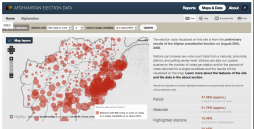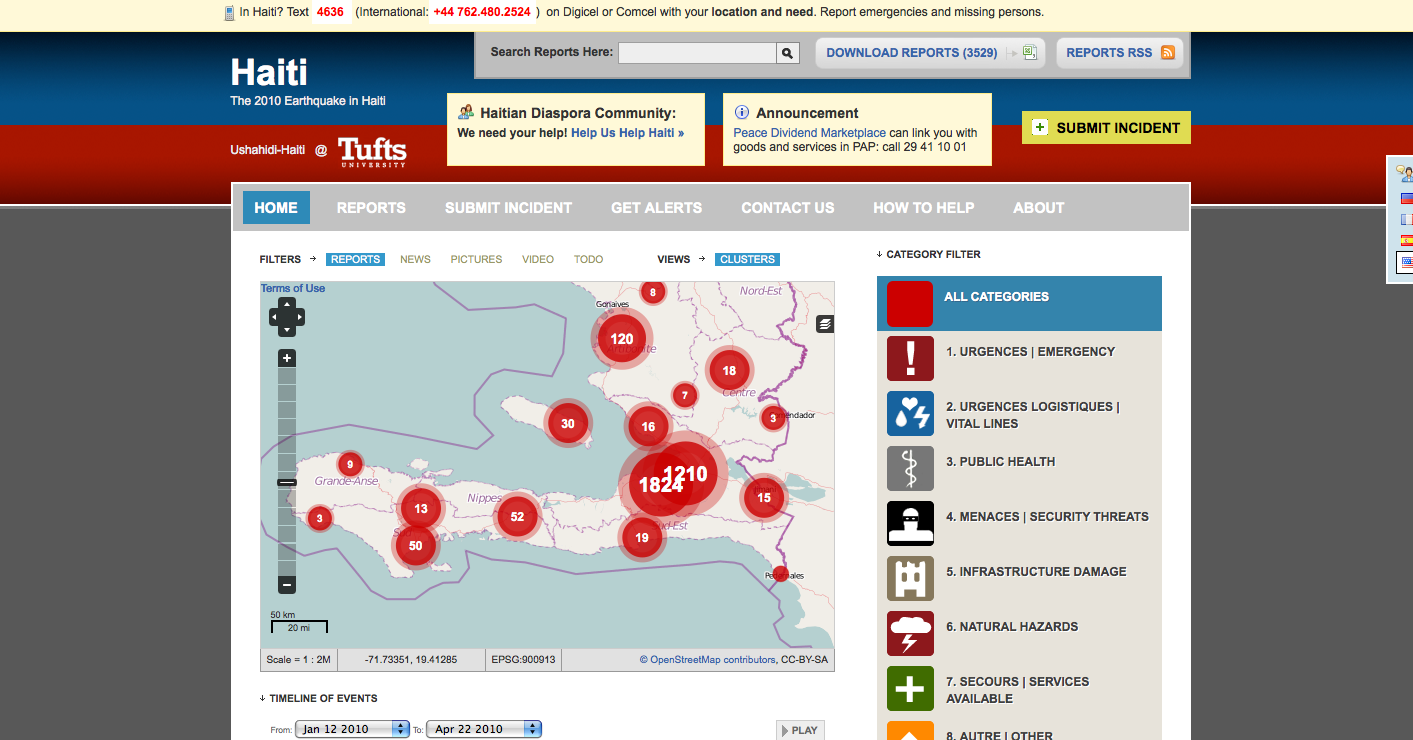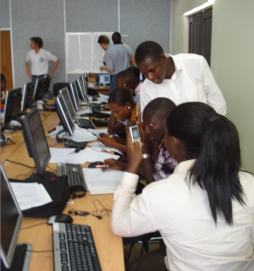SMS reporting
Posted by KatrinVerclas on Oct 05, 2011
Recently, we’ve been seeing a lot of hype about citizen reporting using mobile phones during elections. It is often conflated with the term “election monitoring,” but this does a disservice to both citizen reporting and election monitoring, a discipline and field that has been around for some 20 years. These two approaches have markedly different goals, target audiences, and processes. We think it is time for readers to definitively understand what election monitoring is in contrast to citizen reporting, and what the role of mobile phone and mapping platforms are in regard to these two very different forms of engagement during elections. We aim to clearly differentiate between them once and for all.
We also urge the adoption of differing terms - citizen reporting during an election versus systematic election monitoring. Mobile phones, SMS, and mapping platforms play a role in both citizen reporting and election monitoring, of course.
We believe that more clearly distinguishing between citizen reporting during an election and the discipline of systematic election monitoring will better serve organizations that are considering using mobile technology for either of these engagement processes.
Posted by MelissaUlbricht on Jan 28, 2011
The radio station WNYC is creating on-air and online stories from two things very familiar to people in the Northeastern United States: mobile phones and snow. A snowstorm over the holidays was the heaviest December snowfall in six decades and dumped up to 20 inches in many parts of New York City. The story quickly became one of snow removal and how the city was not removing the snow as quickly as people had hoped.
Jim Colgan and the WNYC newsroom wanted to get a sense of what was happening on the streets. Problem was, there was no good or easy way to do this. The station couldn’t rely on the city for real-time information, and reporters couldn’t get to many of the areas. The answer was to have the listeners share their own reports and stories, via mobile phone.
| Mapping Snow Via Mobile Phone data sheet 2902 Views |
| Global Regions: |
|
| Countries: |
United States
|
Posted by PrabhasPokharel on May 04, 2010
Managing News data sheet 5580 Views
Organization that developed the Tool:
Problem or Need:
A large amount of news and information is produced around various events and topics. Mapping and visualization can be useful ways to track this content. There is a need for tools that allow users to search and track news and information, and republish some of that news and information. Both the back-end and front-end systems allow for mapping and visualization of that information.
Brief Description:
Managing News originated as a news aggregation and republishing platform heavily integrated with RSS/Atom. Users can track a diverse set of RSS/Atom feeds, visualize them, and republish selected reports on a platform that allows for mapping and pluggable visualizations. Managing News has subsequently added SMS functionality to the system. The system is based on Drupal, and integrates several open source projects including OpenLayers, SimplePie, and many Drupal plug-ins.
Tool Category:
App resides and runs on a server
Key Features :
- Aggregate RSS/Atom news
- Republish news as RSS/Atom in customizable channels, or directly to Facebook, Twitter, or email.
- Show news as list, map, timeline graphs, or visualized in other ways.
- Search news.
- Integrate SMS input with SlingshotSMS.
- Configurable location tagging and mapping.
Main Services:
Location-Specific Services and GIS
Information Resources/Information Databases
Platforms:
Linux/UNIX
Mac/Apple/iPhone
Windows
Organizations Using the Tool:
Support Forums:
http://managingnews.com/contact
http://drupal.org/project/managingnews
Reviews/Evaluations:
http://mobileactive.org/howtos/mapping-sms-incident-reports-review-ushahidi-and-managing-news
Is the Tool's Code Available?:
URL for license:
http://managingnews.com/bsd-license
Is an API available to interface with your tool?:
Posted by KatrinVerclas on May 04, 2010
Mapping incidences via SMS has been in the news lately. From the swine flu to requests for assistance to election data, visualization of data submitted and collected with mobile phones and via other channels is a hot topic. We asked our special contributor, Melissa Loudon to compare two platforms: Ushahidi and Managing News. While different, both offer powerful capabilities for mapping reports, news of incidences, and SMS-submitted data.
In this "How-To," we describe the installation process, SMS integration, and the mapping functionality of both platforms. If you have deployed either one of the platforms or have others to add for future reviews, please leave a comment! The full "How-To" article can be found here.
| Mapping SMS Incident Reports: Review of Ushahidi and Managing News data sheet 5407 Views |
| Countries: |
Haiti
Kenya
South Africa
|
Posted by MelissaLoudon on May 03, 2010
Mapping SMS Incident Reports: A Review of Ushahidi and Managing News data sheet 19366 Views
Abstract:
In this how-to, we test out two systems for SMS incident mapping: Ushahidi and Managing News. Incident mapping is a simple but powerful concept that does what it says - using SMS to report a given incidence and mapping the data geographically. This article compares the two platforms, their pros and cons, and outlines when to use either.
In this how-to, we test out two systems for SMS incident mapping. Incident mapping is a simple but powerful concept that does what it says - using SMS to report a given incidence and mapping the data geographically.
It has been used in various scenarios ranging from reports from natural disasters to tracking violent crime, citizen reporting in elections.
Ushahidi, a platform for map and time-based visualizations of text reports, has been used most prominently in crisis mapping. The first instance of Ushahidi tracked the post-election violence in Kenya in 2007, closely followed by an instance covering outbreaks of xenophobic violence in South Africa in early 2008. Following the Haiti earthquake in early 2010, an Ushahidi deployment at Tufts University provided a platform for aggregating, translating and disseminating incident reports and requests for assistance. Ushahidi is an open-source PHP/Javascript platform.
Posted by PrabhasPokharel on Aug 26, 2009
Ushahidi data sheet 4630 Views
Organization that developed the Tool:
Problem or Need:
Gathering crisis information from the general public can provie insights into events happening in near real-time. Allowing easy intake, visualization and mapping of this information can be very valuable. To this effect, the goal is to have an open source application so intake and visualization methods are customisable and deployable in a wide variety of settings.
Brief Description:
Ushahidi is a platform that allows anyone around the world to set up their own way to gather reports by mobile phone, email and the web - and visualize and map them. It is being built so that it can grow with the changing environment of the web, and to work with other websites and online tools.
Tool Category:
Runs on a mobile phone
Runs on a server
Is a web-based application/web service
Key Features :
- Google Map Visualization of Reports
- Integration with SMS input, FrontlineSMS, various Web tools
- Admin panel and Web Input of externally validated stories
- Other planned features
- Various smartphone applications to upload data to Ushahidi
Main Services:
Voting, Data Collection, Surveys, and Polling
Location-Specific Services and GIS
Platforms:
Linux/UNIX
Mac/Apple
Windows
All phones -- SMS
All phones/Mobile Browser
Organizations Using the Tool:
Support Forums:
http://wiki.ushahidi.com/doku.php
http://forums.ushahidi.com
Languages supported:
English, French, Arabic, Others coming
Is the Tool's Code Available?:
URL for license:
http://github.com/ushahidi/Ushahidi_Web/blob/19bbcb381ab8b9f3eac6a718d76eb015d9d9f8fe/License.txt
Is an API available to interface with your tool?:
Posted by PrabhasPokharel on Aug 26, 2009
As I've mentioned, the Mobile Media Toolkit team will be attending the upcoming Highway Africa conference.
We are excited to meet up with Harry Dugmore and Guy Berger at Rhodes University who have been behind the Lindaba Ziyafika ("The News is Coming") project. The project, motivated by a desire to reach young people in Grahamstown, has taken Grahamstown's newspaper and enabled it for mobile-based citizen contributions.
Posted by KatrinVerclas on Jun 05, 2009
Lebanon will hold a critically important parliamentary election on June 7, and election observers from around the world have descended on the country. However, as in many other countries now, there are local organizations and citizen efforts on the ground that are using mobile technology for sophisticated election observation efforts. The Lebanese Association for Democratic Elections (LADE) and the Coalition Libanaise pour l’Observation Elections (CLOE), for example, have put in place an extensive SMS reporting system, for example. LADE will deploy a total of 2,500 volunteer citizen observers throughout the country directly at the 5181 polling stations.
Posted by KatrinVerclas on Dec 07, 2008
The CODEO Election Observation Center for the all-important 2008 Ghanaian election is a busy place. Data operators are sitting on rows of computers monitoring incoming SMS messages from 1,000 polling stations around the country. Mobile phones are ringing constantly with calls from the observers in the field. Maps of the 230 constituencies in Ghana adorn the walls of the modern building at the Kofi Annan International Peacekeeping Training Center in Accra.
The Observation Center, affectionately called the "OC" by CODEO staffers, is the technology hub of the massive amounts of qualitative and vote count data that is pouring in from the more than 4,000 election observers deployed by CODEO, the Coalition of Domestic Election Observers. This makes it by far the largest deployment of election observers in this year's election. Mobile technology, and text messaging in particular, is playing a critical piece in relaying both qualitative data on how the election is being conducted, and quantitative data that will verify the official results issued by the Ghanaian Election Commission.



